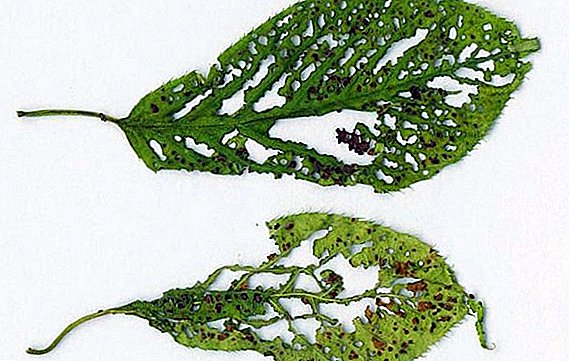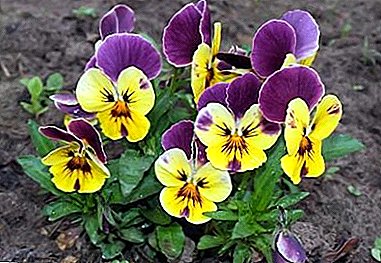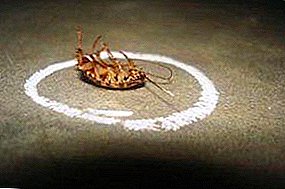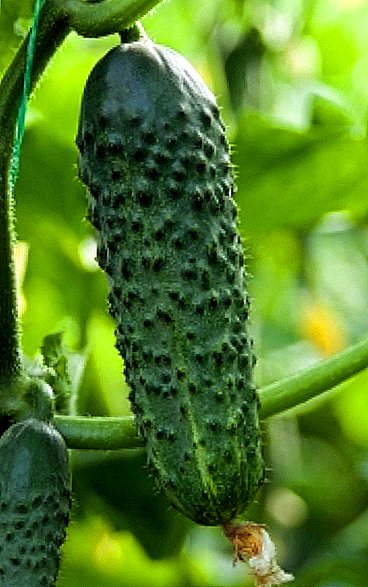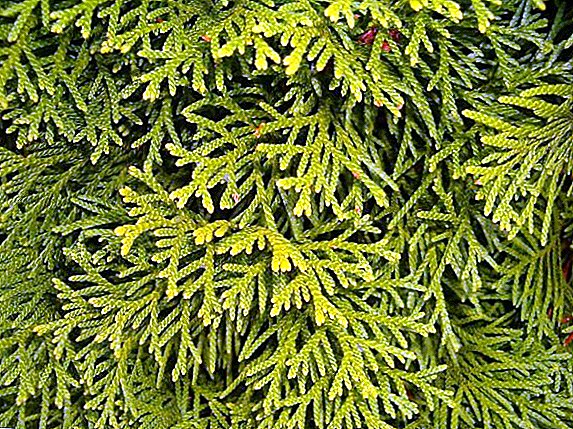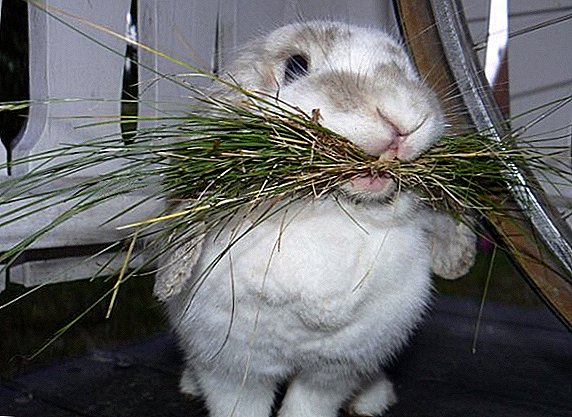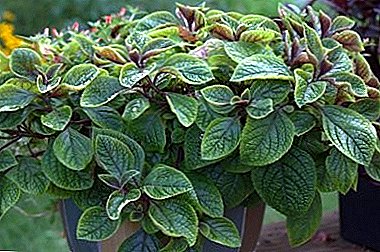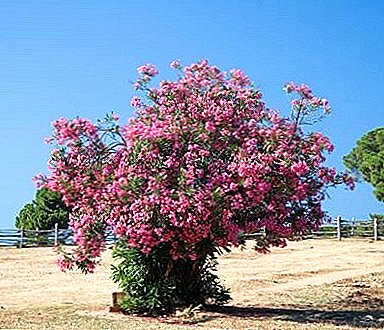
Oleander is a stately evergreen shrub or tree that blooms from summer to mid-autumn.
Its beautiful inflorescences and lush foliage - the decoration of any garden and home.
General description and photo of the plant
Oleander reaches 3-5 m in height when grown in a garden and up to 2 m indoors. The color of the bark is light gray, and the foliage is whorled, dark green. Flowers in diameter range from 3 to 5 cm, inflorescences have the shape of a half-nest of white, pink, dark red or beige color. There are terry varieties. The most common type is common oleander. Among the other representatives - fragrant, pink, Indian, white and pink.
Oleander, flower photo:




What is a room oleander?
It is represented by only one species - oleander ordinary. At home, oleander is growing rapidly, reaching a huge size. Favorably tolerates pruning of the crown, and therefore does not cause inconvenience to room growers.
Flower Homeland
It is located in a wide subtropical strip, stretching from Portugal to China. In Russia and the CIS, oleander grows on the South Coast of the South Caucasus, the Black Sea coast of the Caucasus, the Caucasus, the Central Asian natural zone. In the northern parts of the globe, the plant is distributed as an indoor species.
Care in the home and outdoors
 The flower is well acclimatized in greenhouses and winter gardens, but in apartment conditions, oleander requires very careful and reverent care.
The flower is well acclimatized in greenhouses and winter gardens, but in apartment conditions, oleander requires very careful and reverent care.
ATTENTION!
The capricious oleander requires a cool temperature during the winter period and likes abundant lighting.
How to care for home oleander?
During the care, it is advisable to follow all the rules and regulations with precision so that the fastidious plant grows healthy and pleases with its lush flowering.
Can I keep at home?
At home, oleander can be grown, but it is recommended to maintain the required temperature - cool in winter and warm in summer, as well as give the plant a lot of light. Pruning crown allows you to adapt the flower to the size of your home.
Lighting
Provide plant bright placewhere it will receive a lot of sunlight and fresh air. Best suited windows located on the south side. On the north side you need to use additional light sources.
In winter, oleander also requires bright light. Lamps placed at a distance of 0.7 m from the pot.
Crown formation
How to trim the oleander?
Need a flower in constant pruning due to the rapid growth. Not only cosmetic, but careful pruning is useful for him.
IMPORTANT!
Flowers bloom exclusively on young shoots of the current year.
When flowering ends, you can trim the oleander and form a crown. Shoots are shortened by half, to give the opportunity to grow new. The plant quietly tolerates the cutting procedure.
Watering
 The flower is watered almost all the time abundantly, except for the winter time.
The flower is watered almost all the time abundantly, except for the winter time.
In the summer it is recommended to pour water into the pan in order to keep moisture longer. On cloudy days and during the coolness of the pan, make sure that the pan is on the contrary dry.
Water preferably with distilled water, so that it is soft and warm - a few degrees above room temperature.
Breeding
Oleander can be propagated by cuttings as well as by air layering. Root cuttings, pre-treated with charcoal and dried. Root surface sprinkled with sand, to prevent the process of rotting of the stem.
Venation
Oleander air cuts are rooted using wet sand or a glass tube filled with water. When the roots appear, they are cut off from the mother plant and transplanted into a separate container.
Growing oleander from seeds at home
In forming the flower pods there are seeds - they can be used for planting.
REFERENCE
Sowing soil is prepared from a favorable substrate - turf soil and peat. Seeds need to be pressed to the ground, slightly pressing down. Do not fall asleep with the earth in any case - the seeds need the rays of the sun. Sprouts appear in the second month after sowing!
Landing
Prepare loamy heavy soil for planting oleander. Soil composition in equal shares, using peat, sand, humus and sod soil. The mixture can be replaced by purchased, pour sand into it.
Transfer
Young oleanders need to be transplanted annually, and adults - every 3 years. Transplantation is performed after the roots are covered with an earthen clod. Favorable time - the end of spring - the beginning of summer. It is desirable to shorten old roots by treating the cut sites with charcoal.
Open field maintenance
 Oleander grows beautifully in the garden, flourishing magnificently with gorgeous flowers in yellow, white, pink, red colors.
Oleander grows beautifully in the garden, flourishing magnificently with gorgeous flowers in yellow, white, pink, red colors.
The plant grows quickly on the sunny side, but is absolutely intolerant to the shadow.
Leaving will require minimal:
- shrub normally tolerates dry periods, if it is well watered. Overdoing is also impossible, and then the leaves will turn yellow;
- in the spring it is desirable to feed complex fertilizer;
- periodic crown formation by pruning will help give the plant the desired shape, as it is also useful for getting rid of damaged branches.
Cultivation of seeds in open ground
Remember that oleander seeds cannot survive for a long time. Sow them better immediately after ripeningso that sprouts appear as soon as possible. Soak the seeds in a weak solution of potassium permanganate before sowing. Sow in moist soil, sprinkle with a thin layer of earth. The soil mixture is prepared with the addition of peat and sand.
How to cover the oleander for the winter?
The most convenient way to harbor cropped plant. As a heater, use a film. The shrub can be covered completely, and the trunk is wrapped around the tree.
Diseases and pests
Oleander is tough and well-adapted practically to any conditions. Pests that plague him include:
- shield;
- mealy worm;
- spider mite
To combat them use insecticides or folk methods.
What if the oleander does not bloom?
 If the plant is not cut, removing the tips of old shoots, it will not bloom, because flowers are formed only on young shoots.
If the plant is not cut, removing the tips of old shoots, it will not bloom, because flowers are formed only on young shoots.
More often engage in the formation of the crown for lush flowering shrubs.
Other causes may be a lack of moisture or nutrients. Water the plant in the right amount and do not forget to feed fertilizer, especially if the soil is infertile.
Why have oleander leaves become faded?
Most likely, the oleander lacks light. Shadow for him is extremely destructive, the processes of photosynthesis are disturbed. If it is not possible to transplant, try to increase the access of sunlight to the shrub.
See how flower growers solve problems with oleander in this video:
What if oleander drops foliage?
This is a signal that the plant is in a draft or there is little light. Increase the access of light to it and try to protect from drafts. At the same time, the amount of light must be increased gradually so as not to injure the flower.
Benefit and harm
Lovers of indoor flowers rightly worried about poisonous oleander or not.
Oleander is poisonous, but this does not prevent him from possessing healing properties. When caring for shrubs follow safety rules, and it will not harm you.
ATTENTION!
Observe safety precautions, having this shrub in your home or garden:
- Do not start a flower if you have small children, because all its parts contain poisonous juice;
- during the shaping of the crown, take care of your eyes and lips, better wear safety glasses or a mask;
- wash your hands thoroughly after work;
- Do not put a flowerpot in the bedroom - you can not breathe its fragrance for a long time, which is also dangerous;
- Do not allow poison on the wounds or scratches.
 Among the healing properties of emit the content cardiac glycosides, which when added to drugs stimulate normal blood circulation and the work of the heart as a whole.
Among the healing properties of emit the content cardiac glycosides, which when added to drugs stimulate normal blood circulation and the work of the heart as a whole.
The main thing is to be able to properly handle the plant.
When buying an oleander, remember that the plant loves care and attentive care.
Grow it and enjoy the luxurious flowering!


